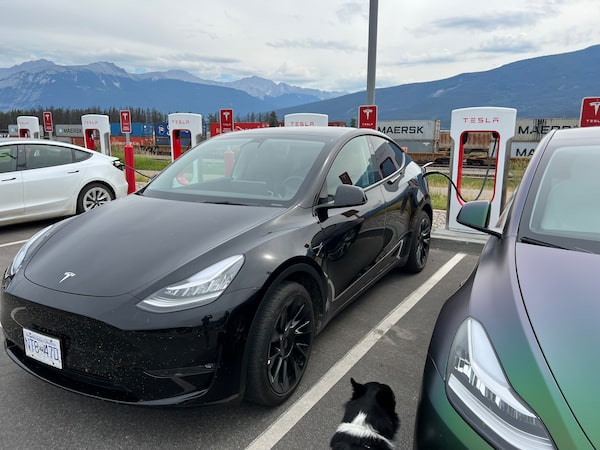
The Tesla Model Y charging in Jasper, Alta.Jason Tchir/The Globe and Mail
If I take a road trip in an electric vehicle this summer, I’d want it to be in a Tesla. It’s not so much because of the car, but because of the chargers.
Last summer, I did the 1,200-kilometre drive from Vancouver to Edmonton and back – with Peter, my eight-month-old border collie, in the back seat – in a 2022 Volvo XC40 Recharge with 359 kilometres of estimated range.
Three weeks later, I did the trip one way in a 2022 Tesla Model Y Long Range with 531 kilometres of posted range. It was a much less stressful experience.
The Volvo trip
I was nervous because the last time I’d made the electric trek across the Rockies – in a Volkswagen e-Golf with 201 kilometres of range in 2018 – what’s normally a 13-hour drive took me 32 hours. I spent nearly 16 hours charging on the way there, plus an overnight hotel stay.
With the Volvo, I wasn’t worried about the car – the XC40 Recharge is a capable, comfortable, polished EV – but about the availability and reliability of the chargers en route.
On the 2018 trip, I had to limp 50 kilometres from Hope to Chilliwack, B.C., on little juice because there was just one fast charger in Hope – and it wasn’t working.
This time, there are more fast chargers – which can charge an EV’s battery from zero to 80 per cent in 30 to 45 minutes, depending on the car and the speed of the charger – along the way. Unlike last time, I wouldn’t have to stop at a Level 2 charger, which would take five or six hours to replenish the battery.
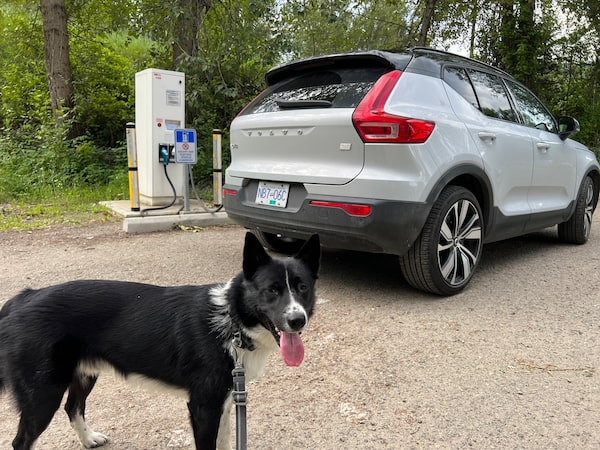
The Volvo XC40 Recharge charging in Little Fort, B.C. while Peter goes for a walk.Jason Tchir/The Globe and Mail
But chargers can be busy – or broken. Instead of range anxiety, I had charging anxiety.
A Better Route Planner (ABRP), an EV route-planning app, said I could do the 1,165-kilometre trip in a total of 16 hours and 30 minutes, with seven charging stops that it estimated would take three hours and 44 minutes. The average length of predicted charge stops was about 30 minutes, with the shortest at seven minutes and the longest at 54.
Why the difference in charging times? The goal is to top up the battery enough to get to the next charger instead of charging to full at every stop. Fast chargers slow down once the battery hits 80 per cent – so topping up the battery to 100 per cent can take at least as long as it took to get to 80.
Because it was my dog’s first trip anywhere farther than the dog park, I decided to add an overnight stay in Valemount, B.C., at a hotel with a Level 2 charger. That would let me skip a fast charge since I could charge overnight.
That was the plan, anyway. The actual trip took much longer. Between a five-hour torrential rainstorm that slowed traffic, stops at dog parks in Kamloops, B.C., and Jasper, Alta., and long stretches of road construction, the trip took about 20 hours over two days – from 7 a.m. to 7 p.m. the first day and from 8 a.m. to 4 p.m. the next. About 4½ hours of that was spent charging. That was mostly while I was off walking the dog, which I would have had to do anyway. Still, there were a couple of charging stops where we sat in the car, in the rain, just waiting.
There were also times when I left the car plugged into the charger longer than I needed to. For instance, in Jasper, Peter spotted an elk near the dog park and wouldn’t move for 20 minutes.
The charging was sometimes a hassle. For instance, the app sent me to Petro-Canada chargers in Hope, Merritt and Kamloops, but the company’s whole network was down most of that day, so they weren’t working. I found alternatives, but one, an Electrify Canada station in Merritt, kept booting me off after a couple of minutes of charging.
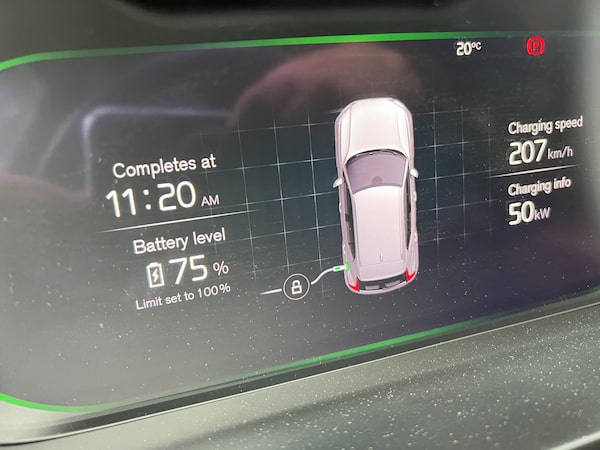
The Volvo's screen shows charging information, including the rate and when it will finish.Jason Tchir/The Globe and Mail
After charging all night at the hotel in Valemount, I woke to find out that the breaker had tripped and I had only a 20-per-cent charge. That meant another 25-minute stop.
I had to use four charging networks and three apps: BC Hydro’s app works with both BC Hydro and Flo chargers. A few times, though, it took two or three attempts to get the chargers working. The good news is that charging cost me a lot less than gas would have – about $50 each way.
I drove from Toronto to Montreal in an EV and faced a mutiny halfway
Over all, getting to Edmonton and back to Vancouver was painless. Unlike that 2018 trip, I didn’t worry once about running out of juice before I could make it to the next charger. I had no complaints about the Volvo either, although a little more range would have helped.
That said, when I unexpectedly had to do that same trip again, three weeks later, I booked a rental car that ran on gas.
Sure, charging hadn’t added that much time to the trip because I had to make a bunch of stops for the dog, anyway. But even though the chargers worked most of the time – eventually – I worried that they wouldn’t.
The Tesla trip
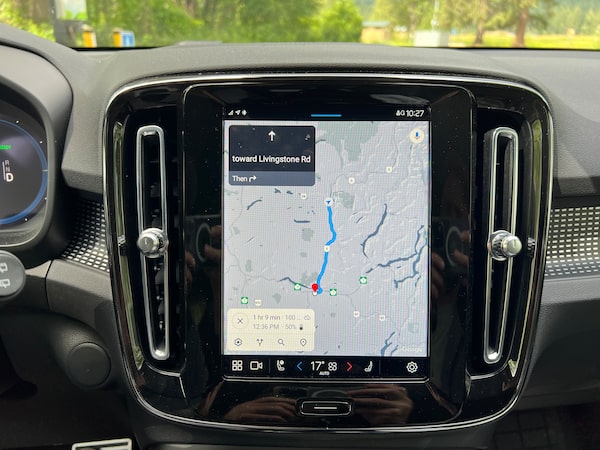
The navigation screen on the Volvo XC40 Recharge shows the route and time to the next stop.Jason Tchir/The Globe and Mail
When I got to the rental counter to pick up the gas vehicle I’d booked for my next journey, the Nissan Kicks wasn’t there. Instead, they asked whether I’d like to try a Tesla Model Y for $40 more a day. I agreed.
So, for five minutes, the rental car employee walked me through how to use the touch screen to turn on the lights and adjust the mirrors and steering wheel.
I hadn’t planned an EV trip, so I quickly checked the app. It said I could do the trip with about an hour and 15 minutes of charging, in total, over four stops. I’d stop overnight in Valemount for the dog again.
On the road, the Model Y was comfortable, peppy and confident. I was excited to try Autopilot on a long trip, but it didn’t work. Neither did cruise control, lane-keep assist or the rear-view camera.
I pulled over, started searching on my phone, and tried updating the car’s software. Then, at a charging stop in Merritt, another Tesla owner shrugged it off – “It’s annoying when that happens” – and told me to try to reboot the car. I did that a few times – it felt like restarting a computer from 20 years ago – and still had no luck. Tesla’s customer service couldn’t help me because it was a rental car. I decided to just drive.
Eventually, the systems would start working for two or three minutes at a time – and then stop again, accompanied by a warning.
Tesla did not respond to requests for comment.
What Tesla lacks in communication with customers, it makes up for in charging infrastructure. The navigation system tells you exactly where to charge and how long to charge for. Some other car makers do that too.
But the real difference is Tesla’s Supercharger network. Tesla’s Superchargers ranked first in a 2022 J.D. Power survey of consumer experiences with EV fast chargers.
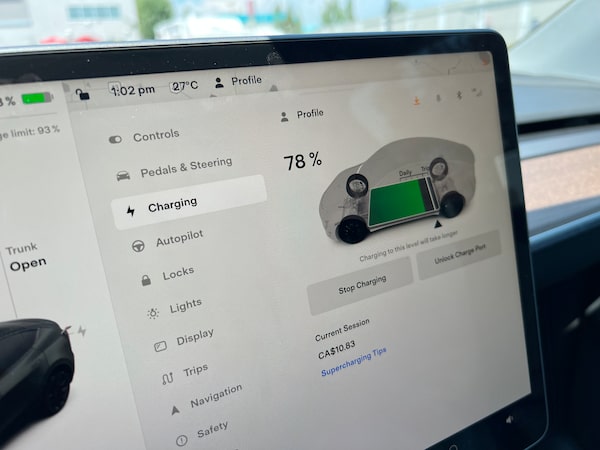
The screen on the Telsa Model Y shows how much it has charged and how much it has cost.Jason Tchir/The Globe and Mail
Not only are there more chargers at their stops – for instance, there were eight Superchargers at a stop in Jasper and two conventional fast chargers – but charging is simple.
You plug in and the car starts charging – and that’s it. There’s no fiddling with apps or waiting for the charger to connect to your car. When it’s done, it bills your Tesla account. In my situation, it was the rental car company’s account that was billed. It’s painless.
It should be the future of charging – but no other company is doing it anywhere near as well. So when Ford announced a deal with Tesla last week that would give all Ford EVs access to the Supercharger network in the United States and Canada as of next spring, Ford shares went up by more than 7 per cent.
In the meantime, I’d gladly put up with the odd glitch on a cross-country trip – just so I can use Tesla’s chargers.
 Jason Tchir
Jason Tchir